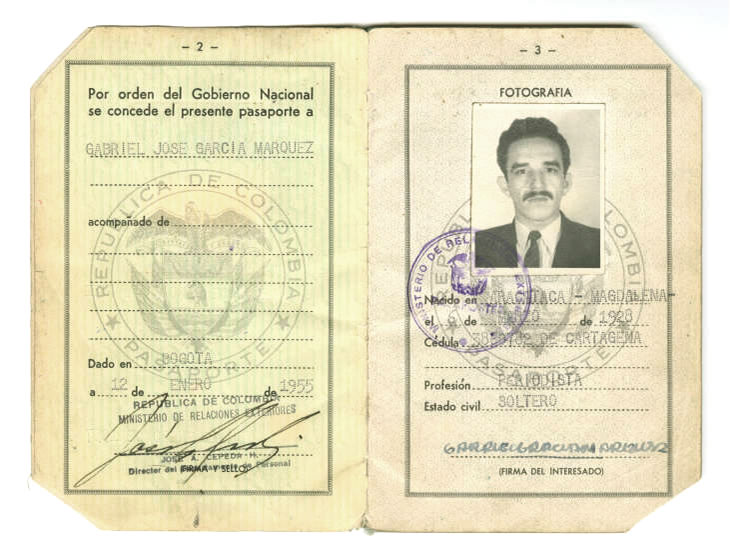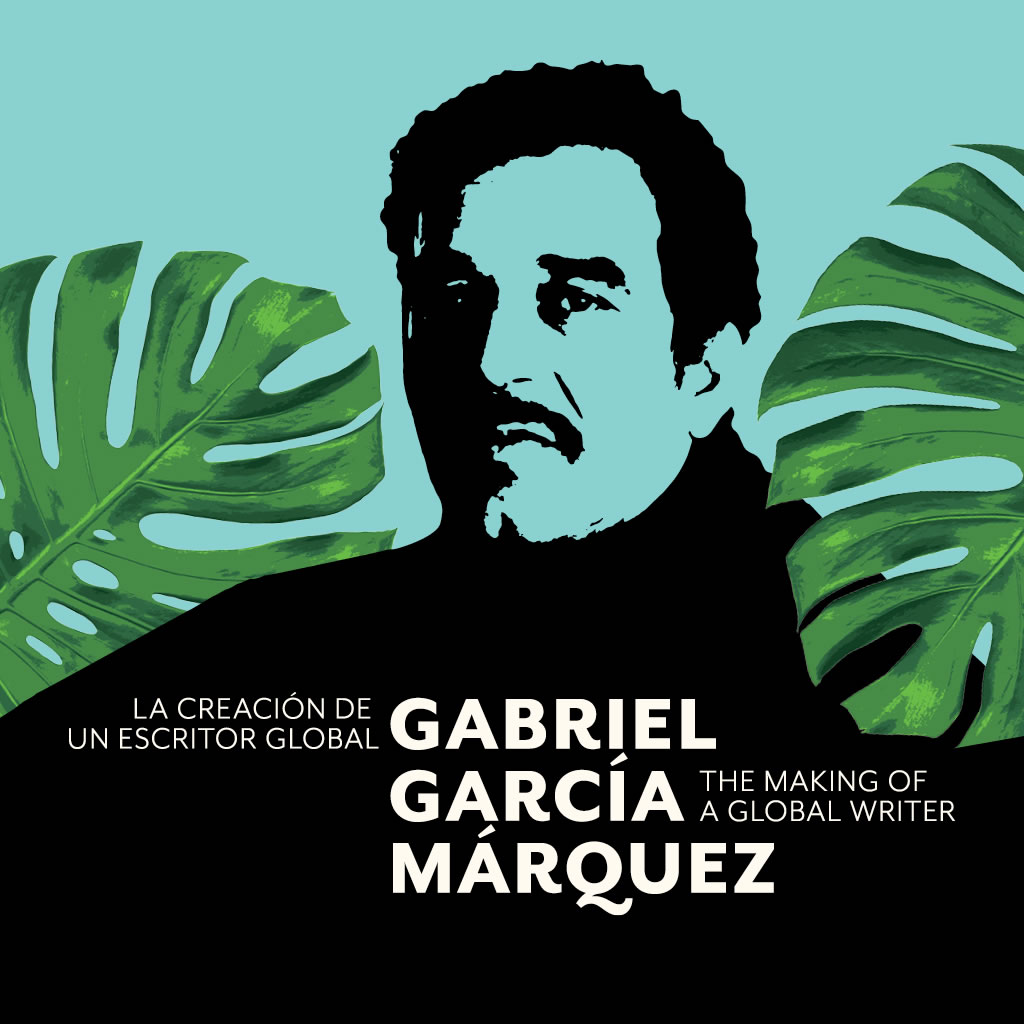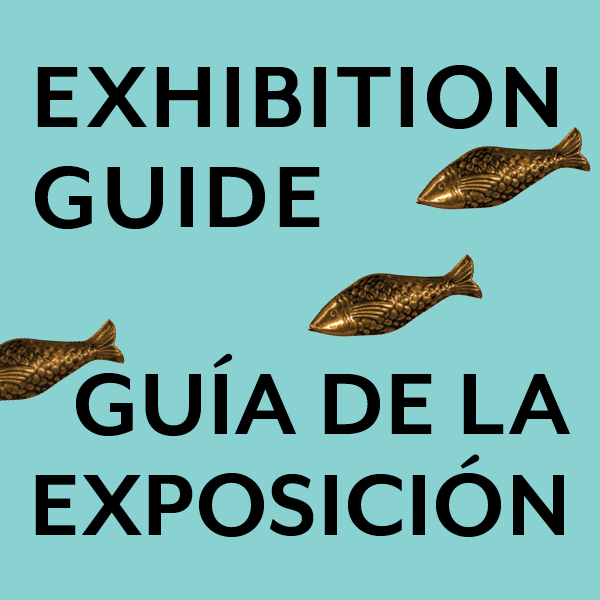Gabriel García Márquez
The Making of a Global Writer
February 1, 2020 – January 2, 2022
In 1965, Gabriel García Márquez was a Colombian writer living in Mexico City. He was mostly unknown beyond literary circles in Mexico and Colombia. For almost two decades, he struggled to become a full-time fiction writer. In 1967, the publication of One Hundred Years of Solitude [Cien años de soledad] and its ensuing international success transformed its author into one of the most celebrated writers of the twentieth century. He was awarded the Nobel Prize in Literature in 1982.
Drawing primarily on the papers of García Márquez acquired by the Ransom Center in 2014, this exhibition is comprised of approximately 300 objects, including numerous documents never seen in public before. These objects show how he became a literary icon. Throughout his life, García Márquez repeatedly thanked his family and friends for their support. Throughout the exhibition, correspondence, photos, and videos illustrate how his professional circle supported his literary career.
This exhibition is curated by Álvaro Santana-Acuña, assistant professor at Whitman College, and author of the book Ascent to Glory: How One Hundred Years of Solitude Was Written and Became a Global Classic.
-
ORIGINS
Gabriel José de la Concordia García Márquez, affectionately known as Gabo, was born in 1927 in Aracataca, Colombia. He lived in this town near the Caribbean coast until the age of eight, in the home of his maternal grandparents.

García Márquez was born in the department of Magdalena, located in Colombia's coastal region near Venezuela. This map was published during García Márquez's childhood and shows the main natural products of Colombia, including the banana plantations in the writer's home region.
Those early years shaped his literary imagination for the rest of his life. His grandfather told him true stories about the town and the region, like the massacre of banana plantation workers. His grandmother told him stories about ghosts and other fantastic events.
Photographs of Tranquilina Iguarán Cotes, 1916, and Nicolás Ricardo Márquez Mejía, 1917, García Márquez's grandparents.
For years, the shy boy lived in a world where the real and the fantastic occupied different rooms of the house of his grandparents. He wrote his first poems, under the pen name of Javier Garcés, and became interested in popular Caribbean music. The memories of the family home in Aracataca started to haunt the young García Márquez. By 1950, at age 23, he tried to write for the first time the story of the Buendía family that 17 years later was published as One Hundred Years of Solitude [Cien años de soledad].
-
OUT IN THE
WORLD
After high school, García Márquez moved to Colombia's capital, Bogotá, where he worked as a journalist and published his first short stories. In 1948, as Bogotá was devastated by the riots known as the Bogotazo, following the assassination of presidential candidate Jorge Eliécer Gaitán, García Márquez returned to the Caribbean coast.

In 1948, García Márquez moved back to the Caribbean coast, where he worked until 1953 for the newspapers El Universal of Cartagena and El Heraldo of Barranquilla. These were his first jobs as a journalist. In 1954, he returned to Bogotá to work for national newspaper El Espectador.

During his career, García Márquez embraced new writing technologies. At first, he used manual typewriters. When he was writing One Hundred Years of Solitude [Cien años de soledad], he bought a Smith Corona, one of the first electric typewriters. He continued to buy new and modern typewriters, like the one in this photograph, which he used in the 1970s.
Gabo joined groups of artists in the cities of Cartagena and Barranquilla, and was influenced by modernist writers James Joyce, Virginia Woolf, William Faulkner, and Ernest Hemingway. Faulkner's techniques inspired García Márquez's first short novel, Leaf Storm [La horajarasca]. And Hemingway's The Old Man and the Sea influenced his first major success, his reportage about a shipwrecked sailor. In 1955, García Márquez left for Europe. In love with Neorealist cinema, he studied scriptwriting in Rome and then lived in Paris, where he wrote his second short novel, No One Writes to the Colonel [El coronel no tiene quien le escriba].
After two years in Europe, he moved back to Latin America in 1958. He married Mercedes Barcha and worked as a freelance writer for magazines in Caracas, Venezuela. In 1961, Gabo moved to New York City to work for the news agency of the Cuban Revolution, Prensa Latina.
-
¡VIVA MÉXICO!
In 1961, García Márquez, his wife Mercedes, and his first son, Rodrigo, left New York for Mexico City. As an immigrant, he struggled to survive financially and had to work for popular magazines such as Sucesos para Todos and La Familia to support his family, which soon added his second son, Gonzalo.
Gabo found work as a scriptwriter and dreamed of moving to Hollywood, but this project fell through. Instead he had to work in advertising in 1963, he believed that he could not become a professional writer. At the same time, Mexico City was rising as a center of the Latin American Boom in literature, where García Márquez witnessed the success of such novels as Mario Vargas Llosa's The Time of the Hero [La ciudad y los perros] and Julio Cortázar's Hopscotch [Rayuela].

A 1963 copy of No One Writes to the Colonel [El coronel no tiene quien le escriba] by Gabriel García Márquez.

Image of Gabriel García Márquez and Julio Cortázar by R. Mellor.
Through his association with these novelists of the Boom and Mexican writer Carlos Fuentes, the leader of a group of artists called La Mafia, García Márquez created lifelong professional connections, changed his literary style and writing habits, and saw his novels translated for the first time. Mexico City ended up being the place where Gabo spent most of the rest of his life.
-
WRITING
SOLITUDE
For more than 15 years, García Márquez worked on a story about the Buendía family and the town of Macondo. In the fall of 1965, with support from his family, friends, and members of the literary group La Mafia, García Márquez quit his job and locked himself up in his studio to write the novel that would bring him world fame.

After so many years of setbacks and unsuccessful attempts to write One Hundred Years of Solitude [Cien años de soledad], in 1965 García Márquez wrote to his friend, Plinio Apuleyo Mendoza, about his new novel: "I'm very happy with it." He noted it would be 800 "sheets" and that he had already written "more than half." At this stage, he had decided the title of the novel, and had sketched the plot of the story, main characters, and key events.
While writing One Hundred Years of Solitude [Cien años de soledad], Gabo exchanged letters with friends and writers in Latin America and Europe, giving them updates on how the novel was going. At home, he read passages and chapters of the novel in progress to his close friends and visitors and received their opinions. Concerned that the novel would not sell, he tested the novel with different publics by publishing excerpts of several chapters in magazines read in more than 20 countries.

Back cover of the book, Into the Mainstream: Conversations with Latin-American Writers (1967) written by Luis Harss and Barbara Dohmann. This pioneering and best-selling book came to define the key personalities of the Latin American Boom in literature. García Márquez was the least well known at the time and inclusion in the book attracted the attention of publishers.
As a result, international expectations about the forthcoming novel grew. When One Hundred Years of Solitude [Cien años de soledad] was published in May 1967, it became an immediate global success and soon changed the course of world literature.

Copy of the first edition of One Hundred Years of Solitude [Cien años de soledad] published in 1967 in Buenos Aires, Argentina, by Sudamericana Press.
-
GABO'S CARPENTRY
In a 1981 interview published in The Paris Review, García Márquez remarked: “Ultimately, literature is nothing but carpentry.” The exhibition includes manuscripts of key literary works written by Gabo between 1975 and 2004, including The Autumn of the Patriarch [El otoño del patriarca], Chronicle of a Death Foretold [Crónica de una muerte anunciada], Love in the Time of Cholera [El amor en los tiempos del cólera], The General in His Labyrinth [El general en su laberinto], and Living to Tell the Tale [Vivir para contarla], among others. Also on view are pages from his unpublished novel We'll See Each Other in August [En agosto nos vemos] and the second, unfinished volume of his autobiography.
These documents reveal some of the nails, screws, and materials of García Márquez's literary carpentry. One of his more powerful tools was his laborious editing of his own writing, producing much-improved drafts from one version to the next. For example, Gabo created 18 draft versions of his last published novel, Memories of My Melancholy Whores.

Page from a draft of Memories of My Melancholy Whores [Memoria de mis putas tristes]. García Márquez was an obsessive editor of his works. Gabo produced seven full drafts of his last published novel, Memories of My Melancholy Whores [Memoria de mis putas tristes], before starting over completely. Then, he worked on another 11 drafts before arriving at a final version.

García Márquez photographed by author and artist Caleb Ives Bach reading, "La memoria de Gabriel…,” an excerpt of his autobiography published in a magazine.
Spanish literary agent Carmen Balcells helped García Márquez with his “carpentry.” She began to represent him in 1962.
-
THE ENGAGED
WRITER
As his international fame grew, García Márquez used it for political and cultural ends. He befriended and met with world leaders such as Cuba's Fidel Castro, U.S. president Bill Clinton, Soviet ruler Mikhail Gorbachev, France's president François Mitterrand, and many others.

President Bill Clinton was a follower of García Márquez's works. Both admired the novels of American writer William Faulkner and this shared admiration was the beginning of a close relationship between the two from the mid-1990s onward. In this letter from 1996, Clinton thanks García Márquez for “promoting common cultural themes throughout the Americas.”
In the 1970s, García Márquez returned to journalism and wrote about the Cuban intervention in Angola, the Pinochet dictatorship in Chile, the guerrillas in nations across Latin America, including Colombia, and other central political issues of the day.

A photocopy of The Washington Post featuring the article, "Colombian Author Writes on Cuba's Angola Intervention" (January 10, 1977).
As a cultural broker, García Márquez corresponded with leading artists of his time. Some, such as Francis Ford Coppola, Marlon Brando, and Akira Kurosawa, sought to adapt his works to films. In the 1980s, García Márquez founded the International Film and TV School in Cuba. The following decade he created in Colombia the Nuevo Periodismo Iberoamericano Foundation (now Gabo Foundation) with the goal of promoting ethical and modern journalism in Latin America.
-
THE GLOBAL WRITER
In 1982, García Márquez was awarded the Nobel Prize in Literature. During the ceremony, he delivered his famous acceptance speech, “The Solitude of Latin America.” The speech demonstrates his cultural and political commitment to the region's development without the interference of foreign powers.
By the time García Márquez received the Nobel Prize, he was already one of the most popular writers in the world. Each new book by him increased his reputation as a global literary icon, with first editions that sold millions and were published in over 20 languages.

Daria Hlazatova, a young reader from the Ukraine wrote and illustrated this letter for García Márquez in 2009, calling him “a true genius.” She also drew flowers for him.

As a global literary star, García Márquez received dozens of awards and honors and thousands of pieces of fan mail. Professors and students in the Department of Spanish at The University of Texas at Austin sent him a telegram to congratulate him for the Nobel Prize.
The face of García Márquez appears on currency, stamps, monuments, and street murals throughout the world. People, places, objects, and even planets are named after the towns and characters in his novels. He has influenced the works of generations of artists, from writers like Paul Auster to Hollywood movies like Guillermo del Toro's The Shape of Water.

Commemorative stamp issued by Colombia, 2014.

50,000 pesos bill issued by Colombia, 2016.
In 2014, people around the world mourned Gabo's death. Six years later, his legacy is alive and evolving, as global audiences anticipate the forthcoming Netflix adaptation of his masterpiece, One Hundred Years of Solitude [Cien años de soledad].

Gabriel García Márquez participating at the IV Congreso Internacional de la Lengua Española in Cartagena which was held from March 26–29, 2007. This conference honored the writer for his career and celebrated the 40th anniversary of One Hundred Years of Solitude [Cien años de soledad], with a new edition published by the Royal Spanish Academy.
-
DIGITAL ARCHIVE
The digital archive of Colombian-born writer Gabriel García Márquez includes manuscript drafts of published and unpublished works, research material, photographs, scrapbooks, correspondence, clippings, notebooks, screenplays, printed material, ephemera, and an audio recording of García Márquez's acceptance speech for the Nobel Prize in Literature in 1982.
The searchable, online archive is comprised of approximately 27,500 items from García Márquez's papers, and was made possible by a Digitizing Hidden Special Collections and Archives grant from the Council on Library and Information Resources (CLIR). The Center also gratefully acknowledges the cooperation of Gabriel García Márquez's family.

All images from the papers of Gabriel García Márquez, Harry Ransom Center.

Exhibition Sponsor
This exhibition is generously funded by
Pilar
and Jaime Dávila.
Community Partners
KUT 90.5 & KUTX 98.9
EASTside
Magazine
Society Texas


Any
views,
findings, recommendations or conclusions expressed in this exhibition do not necessarily
represent those of
the National Endowment for the Humanities.

































